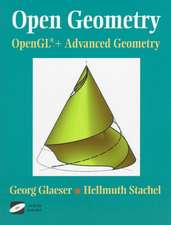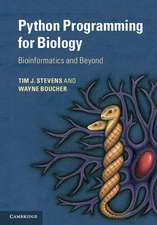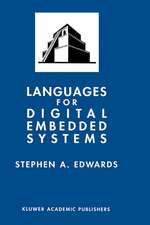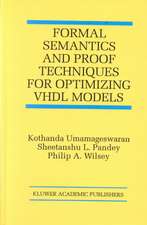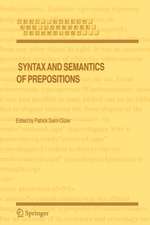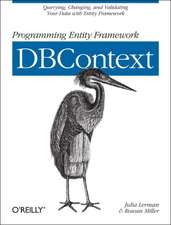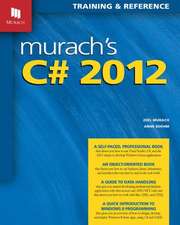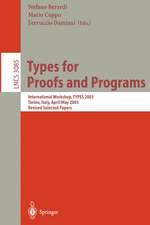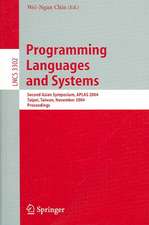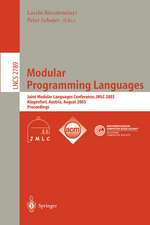An Introduction to Programming in Prolog
Autor Patrick Saint-Dizier Traducere de Sharon J. Hamiltonen Limba Engleză Paperback – 18 dec 1989
Preț: 328.79 lei
Preț vechi: 410.98 lei
-20% Nou
Puncte Express: 493
Preț estimativ în valută:
62.92€ • 65.99$ • 52.37£
62.92€ • 65.99$ • 52.37£
Carte tipărită la comandă
Livrare economică 01-15 aprilie
Preluare comenzi: 021 569.72.76
Specificații
ISBN-13: 9780387971445
ISBN-10: 0387971440
Pagini: 184
Ilustrații: XI, 184 p.
Dimensiuni: 155 x 235 x 13 mm
Greutate: 0.32 kg
Ediția:Softcover reprint of the original 1st ed. 1990
Editura: Springer
Colecția Springer
Locul publicării:New York, NY, United States
ISBN-10: 0387971440
Pagini: 184
Ilustrații: XI, 184 p.
Dimensiuni: 155 x 235 x 13 mm
Greutate: 0.32 kg
Ediția:Softcover reprint of the original 1st ed. 1990
Editura: Springer
Colecția Springer
Locul publicării:New York, NY, United States
Public țintă
ResearchCuprins
1 Representing Facts in Prolog.- 1. Trees.- 2. Facts.- 3. Properties and Relations.- 4. Introducing Facts in Prolog.- Exercises.- 2 Querying the Fact Base.- 1. Elementary Questions.- 2. Questions with Variables.- 3. Conjunction of Elementary Questions.- 4. An Example of a Prolog Execution.- Exercises.- 3 Expressing Rules.- 1. Advantages of Rules.- 2. Constructing a Rule.- 3. Rules without Conditions.- 4. Rules and Logic.- 5. Facts and Rules with Complex Arguments.- 6 Summary.- Exercises.- 4 Syntax of Prolog. The Unification Mechanism.- 1. Numbers and Atoms.- 2. Variables.- 3. Terms.- 4. Clauses.- 5. Formal Definitions of Terms and Clauses.- 6. Substitutions.- 7. Unification of Terms.- Exercises.- 5 Arithmetic Operations.- 1. Arithmetic Operators.- 2. Logical Operators.- 3. Application to Databases.- 6 Procedures.- 1. The Problem.- 2. Procedures.- 3. Execution Order of Clauses in a Procedure.- 4. Procedures and Classical Programming.- Exercises.- 7 Recursion.- 1. Recursion and Recurrence.- 2. Paths in a Graph.- 3. Calculating the Length of a Path.- Exercises.- 8 Structure and Management of Control.- 1. Control Structure.- 2. The Execution Process.- 3. Predicates for Controlling Resolution.- 4. Negation as Failure.- Exercises.- 9 Lists.- 1. Representing Lists.- 2. Searching for an Element in a List.- 3. Set Operations.- 4. Concatenation of Two Lists.- 5. Palindromes.- Exercises.- 10 Predefined Predicates.- 1. Identifying Kinds of Terms.- 2. Decomposition and Construction of Terms.- 3. Input-Output Operations.- 4. Defining New Operators.- Exercises.- 11 Some Programming Advice.- 1. General Principles.- 2. Top-Down Approach.- 3. Testing Prolog Programs.- 4. Thinking in Prolog.- 5. Toward Applications.- 12 Formal Aspects of Programming in Logic.- 1. First-Order Logic.- 2. Clausal Forms and Horn Clauses.- 3. Declarative and Procedural Semantics of Prolog.- 4. SLD Resolution.- 5. SLD Resolution in Prolog.- 6. Meaning of a Program.- 13 Playing with Words.- 1. Crisscross Puzzles.- 2. The Game of Domino.- 3. The Longest Word.- 14 Deductive Databases.- 1. Basic Structures.- 2. A Film Database.- 3. Basic Operations.- 4. Advanced Tools.- 5. Expressing Integrity Constraints.- 6. Problems of Quantification.- 7. A World with Three Truth Values.- 15 An Expert System about Animals.- 1. Structure of an Expert System.- 2. Modeling a Problem.- 3. Guessing Names of Animals.- 4. Toward Actual Expert Systems.- 16 Count It Out.- 1. The Basic Game.- 2. A More Complex Calculation.- 3. Searching for an Approximate Solution.- 17 The Automatic Analysis of Natural Language.- 1. Natural Language and Logic.- 2. Introduction to Logic Grammar.- 3. Semantic Constraints.- 4. Generation of Natural Language.- 5. Automatic Construction of an Analyzer.- 6. A More Complex Logical Formula.- 7. Toward an Evaluator.- Appendix A Exercise Answers.- Appendix B Main Predefined Predicates.


